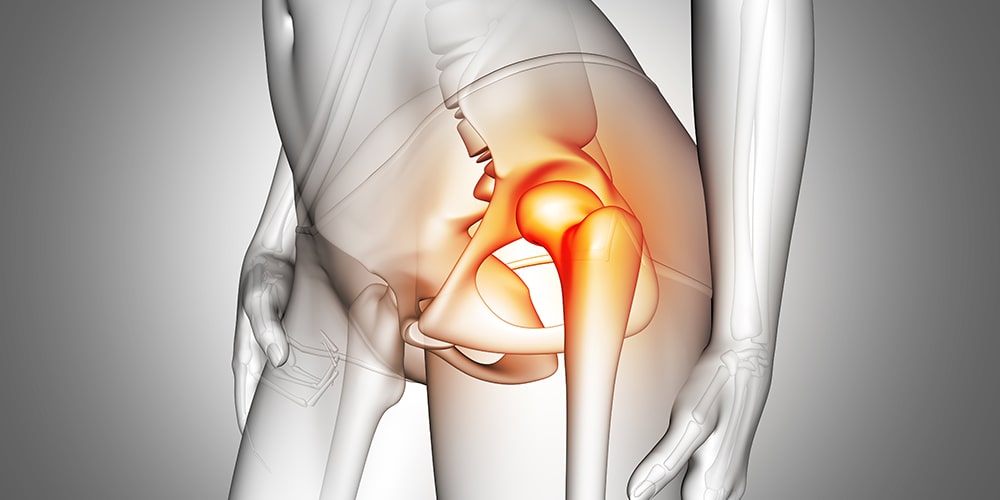
Hip replacement surgery is a medical procedure in which a doctor removes an arthritic hip joint and replaces it with an artificial joint comprised of metal and plastic components. When all other treatment options have failed to offer significant pain relief, hip replacement surgery is performed. The operation helps alleviate pain in the hip joint, while allowing the person to walk more easily.
The following are some of the objectives of hip replacement surgery:
- Relieve hip discomfort caused by a damaged or diseased joint.
- Improve the hip joint’s performance.
- Assist you in moving more efficiently.
- The surgeon aims to make the shortest incision possible during a hip replacement to minimize soft tissue and bone harm.
Types of Hip Replacement Surgery
- Total Hip Replacement: Total hip replacement is the most common form of hip replacement procedure carried out by doctors which involves the removal of the entire hip joint. The joint is replaced by a prosthesis – an artificial ball and socket joint – which is crafted from a hard-wearing, medical grade material. This material can be selected by a patient following a consultation with your hip surgeon, which includes combinations of metal, ceramic and plastic parts. The benefit of this type of procedure is that the two components of the artificial hip are designed to work together, and the affected area is completely removed so that you don’t suffer from further bone-related issues.
- Partial Hip Replacement: As the name suggests, a partial hip replacement involves replacing just one part of the hip joint to remedy a hip related issue. This procedure focuses on replacing the ball element of the ball and socket hip joint, known as the femoral head, with a metal or ceramic hip implant which is set down into the core of the thighbone in order to secure it. Normally, this form of hip replacement is used for repairing a hip joint follow a hip fracture since it treats one specific aspect of the ball and socket joint.
- Hip Resurfacing: Although this isn’t a form of replacement, the end result is similar to a partial hip replacement in that it only makes alterations to the ball part of the joint. Less bone is removed in a hip resurfacing procedure as the original bone socket it left in place and the damaged head of the femur is shaved down by a few millimetres and reshaped to allow a metal cap to be cemented in place. As this preserves more of the bone, it can potentially feel more natural and require less adjusting to. However, hip resurfacing does run the risk of not full addressing the problem or causing further wear to the bone socket, meaning a total hip replacement eventually required. Only specific patients would be suited to this procedure, so consulting with a specialist is recommended to understand whether this be a potentially viable treatment. If you’re struggling with hip-based arthritis issues and have been considering surgery, then contact Kabera Care for an initial consultation with one of our hip surgery specialists. We can provide you with expert guidance on replacement procedures and help guide you through each step so you can get the hip surgery you need and be back on your feet feeling like yourself again.
How do I know if I need a hip replacement?
This may seem a silly question but it is important to realize that a hip replacement is major surgery and so you should really only be considering it when you have run out of other options. A doctor can diagnose arthritis in your hip and they can tell you that a hip replacement is an option for treatment but only you can decide if the time is right for you.
- The main reason for having the operation is that you have a lot of pain and stiffness that cannot he helped by other treatments. The pain and stiffness can affect your ability to walk, to climb stairs, to get out of a chair and to undertake normal everyday household activities.
- Sometimes you will be aware of a grating or grinding feeling coming from your hip. This is called crepitus. Sometimes your hip just doesn’t move as well as it used to.
- Symptoms will often vary from day to day – sometimes for no apparent reason. This is really common.
Why is Hip Replacement Surgery Performed?
The decision to have hip replacement surgery should be a cooperative one made by you, your family, your primary care doctor, and your orthopaedic surgeon. The process of making this decision typically begins with a referral by your doctor to an orthopaedic surgeon for an initial evaluation.
Common reasons for undergoing Hip Replacement includes:
Types of arthritis:
- Osteoarthritis: Osteoarthritis is a degenerative joint disease that affects mostly middle-aged and older adults may cause the breakdown of joint cartilage and adjacent bone in the hips.
- Rheumatoid Arthritis: Which causes inflammation of the synovial lining of the joint and results in excessive synovial fluid, which may lead to severe pain and stiffness.
- Traumatic Arthritis:Arthritis due to injury may also cause damage to the articular cartilage of the hip.
Hip replacement surgery also is used as a method of treating hip fractures. A fracture is a traumatic event that may result from a fall. Pain from a fracture is severe and walking or even moving the leg will be very difficult.
When all the medical treatments fail in controlling the pain due to arthritis, hip replacement surgery may be an effective treatment option.
How is Hip Replacement Performed?
- At the hospital, you will be checked-in upon arrival. After check-in, you will be escorted to your room where you’ll change into a hospital gown. Here, you will wait for your surgeon and meet briefly before being escorted to the operating room.
- In the operating room, you will likely be given either: general anesthetic (being put to sleep), spinal anesthetic, or a combination of the two. There are pluses and minuses to the various types of anesthetic but a common preference by care teams is to go for spinal anesthetic with sedative medication. A spinal block is administered with medication to help your relax. Spinal blocks have lower risk for serious complications than general anesthetic, cause less nausea, and let the patient breath on their own during the operation.
A huge perk for a spinal block (regional anesthetic): pain is blocked for up to 24 hours following surgery.
After you’re comfortable or you’ve gone completely under, it’s go time!
- After your surgeon and team have created a completely sterile environment (yes, there’s a good chance your care team will be wearing space suits), they will make the incision. If you’re having minimally invasive surgery this cut will be 3-5 inches long, whereas a traditional incision may be as large as 8-10 inches. The incision will cut through the skin, tissue and muscles at the top of your thighbone, allowing your surgeon to gain access to your hip bone.
- Once your surgeon can see your troubled ol’ hip joint, he or she will get busy. The first step is generally dislocating your hip (pulling the ball out of its socket). Next, the ball-shaped head of your femur (upper thigh bone) is removed. The socket is then grated down (resurfaced), removing damage caused by arthritis so that a new, artificial cup can be fit into place. The cup is a small metal dome that fits perfectly into the hollow of your bone and is press fit on. As you heal, new bone will naturally grow around this component, securing it even more into place. A plastic, bowl-shaped insert is fastened into the cup and your new socket is formed. This bionic socket is called the “acetabular component” by the medical community.
- With the ball-shaped head of the femur already removed, your surgeon will prepare the inside of your thigh bone (femur) and then place an artificial part into your femur. This piece is called the femoral component. Your surgeon will then need to fit the stem of this piece with a new head (also called a ball). There are many femoral head (ball) sizes and variations, so your surgeon will test which one fits your new, artificial socket the best. Once attached, the ball piece will be “plugged” into the bowl-shaped socket (the acetabular component). Combined, these pieces replace your hip’s natural ball and socket. Just like that, you’ve got yourself a new hip!
- Before surgery is a wrap, your surgeon will test the fit and movement of your new artificial joint. Sometimes this means x-raying to ensure everything is properly fitting. In all cases, your surgeon will stretch your surgical leg into everyday positions. For example, your surgeon will bring your knee toward to your chest, lift your leg upward and so forth. Once your care team is confident that your new joint fits well and can perform natural movements without dislocating, it’s time to lock everything into place.
- A final evaluation is done to make sure your new surgical leg is stable, that both leg lengths match, and once again, that there’s little chance for dislocation. From here, the incision site is rinsed with sterile fluid and the wound is closed with stitches and staples.
- Ta da! Your hip replacement is done!
- After your surgery, you will be moved into the recovery room until you come to. Depending on the type of anesthetic you’ve had, this could take several hours. During this period, you will be closely monitored. Once you’re with it again, you will be moved to your hospital room. Here, you will spend a minimum of 1-2 days before being discharged home or to a secondary care facility.
- During your hospital stay, you will be visited by doctor and nurses who will check your wound and labs and review your progress. You may also be visited by a social worker who will help determine if you can be discharged straight home or if a secondary care center is better for you. Another key member of your care team is a physical therapist. It is not unusual for patients to begin physical therapy on the same day as surgery or in the following morning. Early movement in the hip joint is pivotal to regaining range of motion, avoiding stiffness, reducing swelling and inflammation and ultimately, setting yourself up for future success.
Make an appointment
Our Doctors
-
Dr. Sujoy Kr. Bhattacharjee
Joint Replacement -
Dr. (Maj.) Mukesh Garg
Orthopaedics & Arthroscopy -
Dr. Kamal Verma
Neuro Sciences


